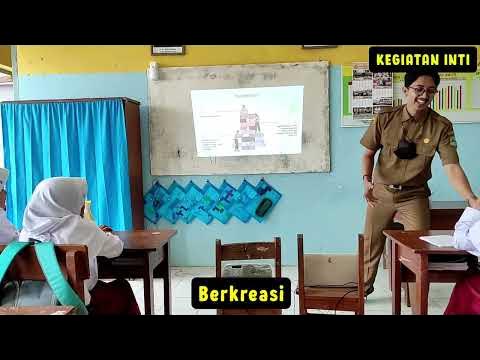Matakuliah: METODOLOGI PEMBELAJARAN - Teams Games Tournaments (TGT)
Summary
TLDRThis lecture discusses the Team Games Tournament (TGT) method, a cooperative learning approach designed to enhance student engagement through group activities and competitions. TGT involves dividing students into diverse teams to foster collaboration and mutual understanding. The method includes five stages: class presentation, group learning, games, tournament, and awarding. TGT encourages motivation, socialization, and active participation. Its advantages include increased learning, better peer interaction, and improved academic performance. However, challenges for both teachers and students include managing diverse abilities and time-intensive preparation. The lecture encourages students to engage in discussions and assignments for deeper learning.
Takeaways
- 😀 TGT (Team Games Tournament) is a cooperative learning model that places students into diverse groups based on differences like ability, gender, ethnicity, and language.
- 😀 TGT aims to help students better understand and teach each other by encouraging collaboration and competition.
- 😀 There are five stages in the TGT process: class presentation, group learning, game phase, tournament phase, and group rewards.
- 😀 The TGT model fosters cooperative learning, where students of varying abilities work together to support each other's learning.
- 😀 The game phase includes a competitive aspect, where students from different groups compete in a tournament format.
- 😀 Rewards and points are given based on students' performance in the tournament, with points distributed depending on how well they perform in the game.
- 😀 In the TGT model, students are not grouped by similar abilities but by diverse backgrounds to foster more inclusive learning.
- 😀 The TGT method emphasizes active student participation, where the teacher acts more as a facilitator than the primary source of information.
- 😀 The model is designed to increase student motivation by making learning fun and competitive, encouraging them to perform better academically.
- 😀 Some challenges include managing diverse student abilities, and it can require more time for preparation and discussions.
- 😀 The model has proven benefits, including improving social skills, tolerance, and empathy among students, while enhancing their academic performance.
Q & A
What is TGT and how is it defined in the script?
-TGT, or Team Games Tournament, is a cooperative learning method that groups students into small teams of 5-6 people. These groups are formed based on diversity in ethnicity, ability, gender, etc., rather than homogeneity, to promote learning from peers with different strengths.
What are the five stages of TGT as mentioned in the lecture?
-The five stages of TGT are: 1) Class Presentation (teacher introduces the lesson), 2) Team Learning (students work in their groups), 3) Games (students participate in games), 4) Tournaments (groups compete against each other), and 5) Rewards (groups are given points based on their performance).
How are students selected for teams in TGT?
-Students are selected for teams based on diversity, including differences in ethnicity, ability, gender, and other characteristics, to encourage varied perspectives and foster cooperative learning.
What is the role of games in TGT?
-Games in TGT serve as a competitive element where students, as representatives of their groups, participate in answering questions. The goal is to encourage students to be more engaged and motivated to perform well academically.
What is the significance of the 'Rewards' stage in TGT?
-The 'Rewards' stage is important as it incentivizes students to perform better by assigning points based on individual performance in the tournament. It helps reinforce learning and motivates students to be more involved.
What are some key characteristics of TGT according to the lecture?
-Key characteristics of TGT include small group collaboration (5-6 students), competition between teams, and the rewarding of groups based on individual performances. The method emphasizes working with diverse groups and learning from peers.
What are the rules of the TGT game?
-The rules of the TGT game involve each team selecting a representative to participate. The representative answers questions individually, and the answers are scored based on correctness. The teacher then rewards points based on the number of correct answers.
What are some advantages of TGT for students?
-Advantages of TGT for students include increased motivation to learn, improved socialization skills, the opportunity to learn from peers, and enhanced academic performance due to the competitive yet supportive environment.
What challenges do teachers face when implementing TGT?
-Teachers may face challenges in grouping students with diverse academic abilities and ensuring effective communication among students. Additionally, managing time for preparation and the class discussions may require more effort.
How does TGT help students develop social skills?
-TGT encourages students to work together in diverse teams, helping them develop tolerance, respect for others' opinions, and the ability to collaborate. This process enhances their social interaction skills and teaches them to value diversity.
Outlines

This section is available to paid users only. Please upgrade to access this part.
Upgrade NowMindmap

This section is available to paid users only. Please upgrade to access this part.
Upgrade NowKeywords

This section is available to paid users only. Please upgrade to access this part.
Upgrade NowHighlights

This section is available to paid users only. Please upgrade to access this part.
Upgrade NowTranscripts

This section is available to paid users only. Please upgrade to access this part.
Upgrade NowBrowse More Related Video

LEARNER-CENTERED TEACHING and It's Teaching Strategies/Educ-5 Ma'am Nona Villanueva

SI 2011: Process Oriented Guided Inquiry Learning POGIL - Jennifer Poutsma

Model Pembelajaran Think Pair Share (TPS) Berbasis Sosial Media

Shaping the Way We Teach English: Module 01, Contextualizing Language

Ragam Strategi Pembelajaran PKn

What is…Active Learning?
5.0 / 5 (0 votes)